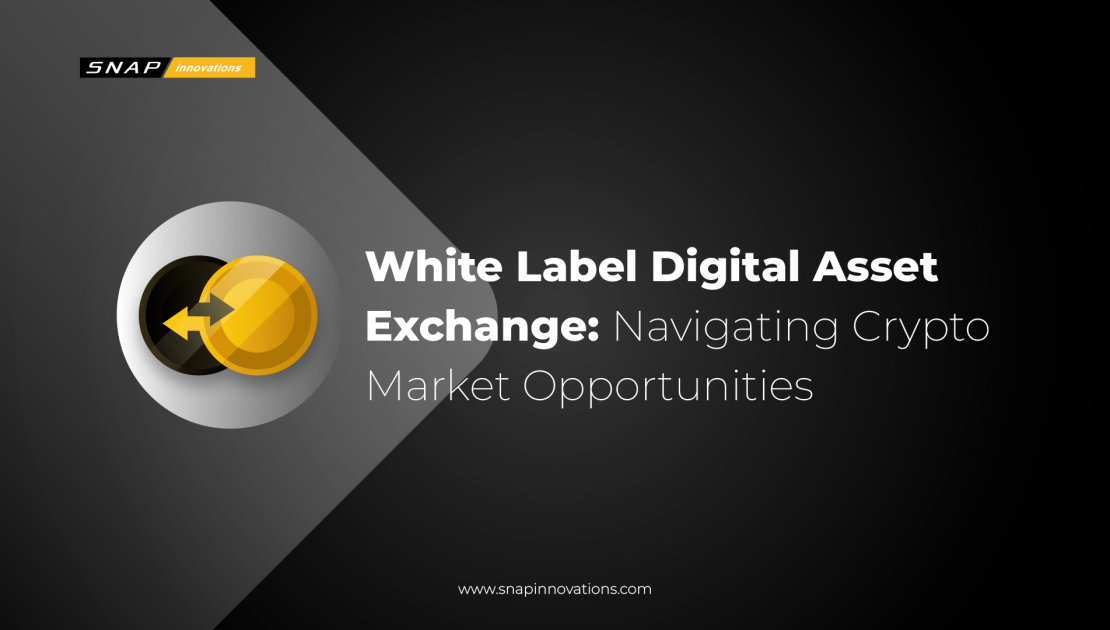Welcome to the exciting world of white label digital asset exchanges! In this comprehensive guide, we’ll delve into the ins and outs of white label exchanges and explore the countless opportunities they offer in the ever-evolving crypto market.
As cryptocurrencies gain mainstream recognition and adoption, the demand for user-friendly and reliable platforms for buying, selling, and trading digital assets has never been higher. White label digital asset exchanges are emerging as a powerful solution for entrepreneurs and businesses looking to tap into this burgeoning market without the daunting task of building an exchange from scratch.
In this article, we will break down the concept of white label digital asset exchanges, discuss their advantages, explore how they work, and shed light on the immense potential they hold for both startups and established enterprises.
What is a White Label Digital Asset Exchange?
 A White Label Digital Asset Exchange represents a readily deployable software solution designed to facilitate the launching of cryptocurrency trading platforms, alleviating businesses from the rigors and complexities associated with extensive technical development.
A White Label Digital Asset Exchange represents a readily deployable software solution designed to facilitate the launching of cryptocurrency trading platforms, alleviating businesses from the rigors and complexities associated with extensive technical development.
This innovative solution is termed ‘white label’ because it offers a neutral foundation that can be tailored, branded, and modified to align with the distinct visual and operational preferences stipulated by the business owner, thereby creating a unique identity for the exchange.
At its core, a white label exchange embodies a comprehensive, pre-constructed framework encompassing critical functionalities essential for the smooth operation of a digital asset exchange. The pre-fabricated software comprises an Order Matching Engine, an indispensable component that efficiently pairs buy and sell orders in real-time, ensuring that trades are executed promptly and fairly, providing users with a seamless trading experience.
Another cornerstone of the white label exchange is Wallet Integration. This feature not only offers secure storage for various digital assets owned by users but also supports an extensive array of cryptocurrencies, enhancing the platform’s appeal by providing users with a multitude of trading options. Wallets integrated into the system are fortified with advanced security protocols, safeguarding users’ assets from unauthorized access and cyber threats.
Read More: Due Diligence: Protecting Your Investments
How Do White Label Digital Asset Exchanges Work?
 White label digital asset exchanges are customizable platforms that allow entrepreneurs and businesses to launch their own crypto exchanges without building the system from scratch. These exchanges are primarily built around several fundamental components.
White label digital asset exchanges are customizable platforms that allow entrepreneurs and businesses to launch their own crypto exchanges without building the system from scratch. These exchanges are primarily built around several fundamental components.
Firstly, the Order Matching Engine is a crucial element that efficiently processes and executes buy and sell orders, ensuring fair and streamlined trading activities. This engine plays a pivotal role in managing the trade requests on the platform.
Another integral component is Wallet Integration, responsible for the secure storage of users’ digital assets. It is essential for these wallets to be integrated with a variety of cryptocurrencies to provide users with diverse trading options, thereby making the platform more appealing to a broad audience. The secure and versatile wallets offer a safe haven for users’ assets while facilitating different crypto transactions.
Furthermore, the User Interface (UI) and User Experience (UX) are the front-end components of the exchange. These aspects are customizable, allowing businesses to tailor the trading interface to reflect their branding, design preferences, and unique identity. A user-friendly and visually appealing interface is pivotal as it enhances users’ trading experiences, encouraging them to engage more with the platform.
Opportunities in the Crypto Market for White Label Digital Asset Exchange
 The crypto market has evolved from a niche interest to a global financial phenomenon, offering a multitude of opportunities:
The crypto market has evolved from a niche interest to a global financial phenomenon, offering a multitude of opportunities:
1. Asset Diversification
Cryptocurrencies offer an attractive avenue for diversifying investment portfolios. With traditional financial markets subject to volatility and economic uncertainties, cryptocurrencies can serve as a hedge against such risks.
Investors can allocate a portion of their assets to digital currencies, potentially reaping the benefits of uncorrelated returns.
2. Entrepreneurship
The growing demand for crypto trading platforms provides a fertile ground for entrepreneurship. Launching a white label digital asset exchange can be a lucrative endeavor.
Beyond trading, crypto startups can explore innovative solutions in areas like blockchain technology, decentralized finance (DeFi), and non-fungible tokens (NFTs).
3. Blockchain Technology
Blockchain, the underlying technology of cryptocurrencies, has far-reaching applications across various industries. In finance, blockchain can streamline cross-border payments and settlements, reducing costs and transaction times.
Supply chain management can benefit from enhanced transparency and traceability. Healthcare can utilize blockchain for secure patient data management. Exploring blockchain-based projects and partnerships can lead to groundbreaking solutions.
4. Financial Inclusion
Cryptocurrencies have the potential to bridge the financial inclusion gap by providing unbanked and underbanked populations with access to banking, payments, and investment opportunities.
Initiatives like digital wallets and peer-to-peer crypto lending platforms enable individuals in remote areas to participate in the global financial system.
5. Technological Advancements
The crypto market is at the forefront of technological innovation. Developers and tech enthusiasts can actively contribute to blockchain projects, smart contract development, and the creation of decentralized applications (DApps).
This innovative space continuously evolves, offering opportunities for those who can adapt and stay at the cutting edge.
6. Education and Advocacy
The adoption of cryptocurrencies depends on education and advocacy. Becoming a crypto educator or advocate can help demystify this complex space for newcomers.
Offering educational resources, hosting webinars, or participating in community initiatives can contribute to the broader understanding and acceptance of cryptocurrencies.
7. Global Reach
Cryptocurrencies operate without geographical boundaries, enabling businesses to expand their reach internationally with relative ease.
This global accessibility can lead to increased sales, partnerships, and the exploration of new markets. It’s important to adapt your business strategy to cater to a diverse and international customer base.
8. Institutional Investment
The entry of institutional investors into the crypto market signifies its increasing maturity. This trend presents opportunities for businesses to offer services tailored to institutions, such as crypto custody solutions, OTC trading desks, and advisory services. Building relationships with institutional clients can be a lucrative avenue.
9. Niche Markets
Within the crypto space, various niche markets and sectors have emerged. Non-fungible tokens (NFTs) have gained popularity in the world of digital art and collectibles. Decentralized finance (DeFi) projects have disrupted traditional financial services. Blockchain-based gaming is on the rise.
Exploring these niches can lead to specialized business opportunities, partnerships, and a dedicated user base.
The crypto market’s diverse opportunities are ripe for exploration, and seizing them requires a combination of innovation, adaptability, and a deep understanding of the evolving landscape.
Building a Successful White Label Digital Asset Exchange
Building a prosperous white label digital asset exchange involves a multifaceted process that requires a deep understanding of the crypto market and a well-thought-out strategy. Let’s explore each key strategy and consideration in more detail:
1. Market Research
Comprehensive market research is your compass in the crypto landscape. Delve into your target audience’s demographics, behaviors, and preferences. Understand the competitive landscape by studying existing exchanges.
Identify gaps in their offerings, and pinpoint what sets your exchange apart. Market research equips you with invaluable insights to tailor your exchange to meet the specific demands of your user base.
2. Regulatory Compliance
The regulatory environment for cryptocurrencies is highly dynamic and often complex. Engage with legal experts who specialize in crypto regulations to ensure your exchange adheres to the ever-evolving compliance landscape.
Develop a robust compliance strategy that includes comprehensive KYC (Know Your Customer) and AML (Anti-Money Laundering) procedures, transaction reporting, and a clear understanding of local licensing requirements. Staying compliant with regulations is critical for the long-term viability of your exchange.
3. Security First
Security should permeate every aspect of your exchange. Employ industry best practices to safeguard user funds and data. Implement cold storage solutions for cryptocurrencies, conduct regular security audits, and keep your team up-to-date on the latest security threats and mitigation techniques.
Building trust through top-notch security measures is paramount in an industry where trust is everything.
4. Liquidity Partnerships
Ensuring liquidity is the lifeblood of any exchange. Forge strong partnerships with reputable liquidity providers, market makers, and trading desks.
A liquid exchange attracts traders as it allows them to execute trades quickly and at competitive prices. A well-managed order book is a cornerstone of your exchange’s success.
5. User Interface (UI) and User Experience (UX)
An intuitive and user-friendly trading experience is fundamental to attracting and retaining users. Invest in UI/UX design to create an interface that is not only visually appealing but also easy to navigate.
Conduct extensive user testing to identify pain points and continuously refine the interface based on user feedback. A smooth and efficient UI/UX will enhance the overall trading experience and drive user loyalty.
6. Scaling Infrastructure
Scalability is key to accommodating growth effectively. A sudden surge in user activity can strain your infrastructure, leading to downtime or performance issues.
Implement load balancing, cloud-based solutions, and scalability plans to ensure your platform can expand seamlessly with user demand. Preparedness for growth is essential for maintaining a reliable exchange.
7. Marketing and Branding
Develop a comprehensive marketing strategy that encompasses various channels, including content marketing, social media promotion, and targeted advertising campaigns.
Consistency in branding helps your exchange stand out in a crowded market. Engage actively with the crypto community, collaborate with influencers, and host webinars or events to broaden your reach. Building brand recognition and community engagement are essential elements of your long-term marketing success.
8. Customer Support
Stellar customer support is a cornerstone of user satisfaction. Offer a range of support channels, including live chat, email, and phone support. Create a knowledge base or FAQ section to address common user queries.
The responsiveness of your support team matters greatly; ensure they are well-trained and readily available to assist users promptly. Positive interactions with customer support can significantly impact user retention.
9.Risk Management
Cryptocurrency markets are known for their volatility. Implement robust risk management protocols to mitigate potential issues, including margin trading mechanisms, stop-loss orders, and position limits.
Develop comprehensive contingency plans to address adverse market conditions and system failures. Effective risk management safeguards both your exchange and your users’ assets.
10. Compliance Reporting
To adhere to regulatory requirements, implement automated compliance reporting tools. These tools help track and report suspicious activities, ensuring your exchange’s compliance with AML and KYC regulations.
Regularly review and update these reporting mechanisms to stay in line with evolving regulatory standards.
11. Marketing Analytics
Continuous analysis of marketing analytics is vital for evaluating the performance of your campaigns. Monitor user acquisition channels, conversion rates, user behavior on your platform, and the ROI of various marketing initiatives.
Data-driven insights should guide your decision-making process, enabling you to refine your marketing strategies and allocate resources effectively.
12. Continuous Innovation
Staying ahead in the crypto industry demands a commitment to innovation. Keep a close eye on emerging technologies and trends.
Regularly update and enhance your exchange’s features and functionalities to meet evolving user expectations. Engage actively with the crypto community to gather feedback and ideas for improvement. Innovation is key to remaining competitive in a dynamic and rapidly evolving market.
Building a successful white label exchange is an intricate journey that demands meticulous planning, continual adaptation, and unwavering commitment to user satisfaction and security. By addressing these strategies and considerations comprehensively, you can establish a resilient foundation for your exchange and increase your chances of long-term success in the fiercely competitive crypto market. Remember that success in this space hinges not only on technical excellence but also on regulatory compliance and the trust you build with your users.
Also Read: Defi Staking Platform Development: Key Steps and Considerations
Conclusion
In conclusion, white label digital asset exchanges open doors to exciting opportunities in the crypto market. Whether you’re an entrepreneur looking to launch your exchange or an established business seeking diversification, white label solutions offer a cost-effective and efficient way to enter the world of cryptocurrencies.
However, success in the crypto space requires careful planning, adherence to regulatory requirements, robust security measures, effective marketing, and a commitment to building trust with users. By navigating these challenges and seizing the opportunities presented by cryptocurrencies, you can carve out a rewarding niche in this dynamic and evolving industry.
So, are you ready to explore the world of white label digital asset exchanges and make your mark in the crypto market? The possibilities are limitless, and the journey promises to be both exciting and rewarding.


